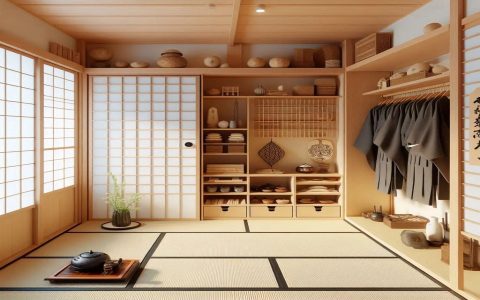Authentic Japanese apartment interiors prioritize minimalism, natural materials, and flexible spaces. Here are essential must-haves:
Core Elements
- Tatami Flooring: The foundational element, traditionally using rush grass mats. Even a partial tatami area (e.g., a sleeping alcove) defines the space. Modern alternatives mimic the look and texture.
- Shoji Screens: Sliding panels with translucent washi paper over a wooden lattice grid. Essential for diffusing light and creating flexible room divisions or window coverings.
- Fusuma Doors: Opaque sliding doors used for closets (oshi-ire) or dividing larger rooms. Feature simple frames often with subtle paper or fabric coverings.
Furniture & Furnishings
- Zabuton Cushions: Low, flat floor cushions used for seating (often paired with a low table). Easily stored when not in use.
- Low Dining Table (Chabudai/Kotatsu): Chabudai is a short-legged table, while a Kotatsu features a heat source under a blanket-covered frame.
- Futon (Shikibuton): A thin, rollable mattress placed directly on tatami or a platform for sleeping. Stored in the oshi-ire (deep closet) during the day.
Storage Solutions
- Built-in Closets (Oshi-ire): Deep, sliding-door closets for storing futons, clothing, and belongings. High capacity, keeping clutter hidden and maintaining clean lines.
- Tansu Chests: Traditional wooden storage chests. Smaller tansu pieces add authenticity without dominating modern spaces.
Entrance & Flow
- Genkan Entryway: A sunken transition area for removing shoes. Even a shallow definition reinforces this cultural ritual and keeps dirt contained.
- Consistent Floor Levels: Minimizing steps and thresholds within the apartment ensures smooth flow and reinforces the concept of flexible space.
Aesthetics & Textiles
- Neutral & Natural Palette: Dominated by wood tones, bamboo, stone, white, beige, and soft greys. Color comes sparingly through textiles or art.
- Nature Integration: Strategic placement of plants (bonsai, bamboo, moss) or mini Zen gardens brings nature indoors.
- Subtle Textiles: Simple cotton, linen, or hemp fabrics in solid, muted colors or subdued patterns (e.g., stripes, small florals) for cushions and window treatments.
Key Principles for Authenticity
- Ma (Negative Space): Embrace emptiness. Clear surfaces and uncluttered floor space are crucial.
- Wabi-Sabi: Appreciate imperfection, asymmetry, and the patina of natural materials.
- Flexibility: Furniture is low, movable, or stored away to transform room function instantly.







